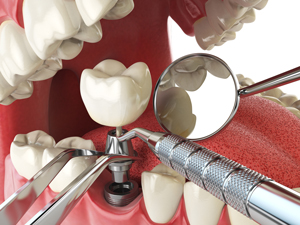Improvements in implant technology are making them increasingly attractive to doctors and patients.
 Twenty years ago, patients who were missing one or more teeth did not have many options when it came to replacing them; often, they had to go to a specialist for treatment. That is not the case today.
Twenty years ago, patients who were missing one or more teeth did not have many options when it came to replacing them; often, they had to go to a specialist for treatment. That is not the case today.
Dental implants have become increasingly popular among patients, not only because they offer a number of advantages over traditional bridges, but because they have become much more routine to place. In fact, in most parts of the world, typically it is the general dentist who now places the implant, according to Madhu Mahadevan, DDS, clinical director for Tru Family Dental.
Indeed, improvements in implant technology are making them increasingly attractive to doctors and patients alike, notes Mahadevan. “Implant manufacturers have improved surface treatment, exterior design and connection type, all which have led to better implant integration and reduced bone loss,” he says. Now, too, dentists have access to a great variety of implant sizes, enabling them to customize the implant to fit the amount of bone available in the patient’s mouth.
“As more adjunct services become available – including cone beam computed tomography (CBCT) X-rays, surgical stents for guided surgeries, bone grafting, sinus augmentation and platelet-rich fibrin (PRF) membrane placement – implant surgeries are much more successful,” says Mahadevan. “Advances in CBCT imaging have allowed implant surgeons to view bone levels and density in a 3D radiographic rendering. Vital structures, such as nerves and vessels, can be seen on the CBCT, which may not be clear on a traditional panoramic radiograph. And advances in bone grafting, sinus augmentation and PRF membrane placement have led to more customizable options for implant placement, better healing and faster recovery times for patients.”
The pros and the cons
All that said, placing an implant is still considered a surgical procedure and, as such, dentists should discuss their patients’ options with them. On the plus side, placing an implant does not require the adjacent teeth to be altered in any way. By comparison, bridgework necessitates the two teeth adjacent to the missing space be irreversibly altered, which can sometimes lead to further issues, notes Mahadevan. In fact, implants can be placed even when the adjacent teeth are unhealthy, whereas a bridge cannot. Also, with an implant, patients can floss more easily than with a bridge. Implants help maintain healthy bone levels, are more functionable and typically look nicer than bridges.
On the other hand, implants take more time to place than a bridge, according to Mahadevan. “Implants can take as long as a year to complete, whereas a bridge can sometimes be completed in two weeks,” he points out. Common risks include fracture or overloading of the implant, infection or peri-implantitis, damage to the surrounding nerves, blood vessels or teeth, poor positioning of the dental implant, poor bone quality and more. And, unlike bridges, implants aren’t always fully covered by insurance plans. Nor is every patient a candidate, he adds. “Heavy smokers, unstable diabetics and patients who take bisphosphonates typically are not good candidates for implant therapy.
“Much of the risk associated with placing dental implants can be avoided with proper patient selection or by taking a detailed medical history, reviewing a CBCT of the patient’s jaw before planning the surgery, understanding proper occlusion when restoring the implant and thoroughly educating the patient about proper oral hygiene,” he continues.
Implantologists who work in a large group setting are at an advantage, he points out. “The implantologist at a large group practice or dental service organization typically has a restoring dentist on hand at the time of surgery,” he explains. “The restoring dentist can provide feedback regarding the placement of the implant, which most certainly will lead to a better end result for the patient.”
Endosteal vs. subperiosteal
Dentists can select from two types of implants: endosteal, which are placed in the patient’s bone, and subperiosteal, which are placed between the patient’s gum tissue and bone. “Endosteal implants are most commonly used,” says Madhu Mahadevan, DDS, clinical director for Tru Family Dental. “Given the recent advances in bone augmentation, implant design and zygomatic implant techniques, subperiosteal implants tend not to be a dentist’s first choice.
“Subperiosteal implants should be placed when the patient’s bone in the maxilla or mandible is atrophied and limited,” he continues. “Using a subperiosteal implant for these patients helps them avoid bone grafting.” And, since the implant sits on top of the bone rather than within it, the healing process tends to be faster, he notes.
Whenever possible, however, Mahadevan recommends the use of an endosteal implant. “The advantage of the endosteal implant is that it is much more stable and has a very low failure rate compared to subperiosteal implants,” he says.

